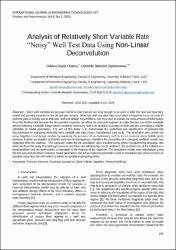Analysis of Relatively Short Variable Rate “Noisy” Well Test Data Using Non-Linear Deconvolution
Özet
Short well test data are pressure-rate-time data that are not long enough to be used to infer the reservoir boundary
model and are very common in the oil and gas industry. Short rate well test data may occur when companies try to cut costs of
well test jobs or mostly due to improper well test design. Nevertheless, one may wish to extract the most amount of information
from this limited data because the de-convolve response can allow the reservoir engineer to make the best use of the available
data in selecting a suitable interpretation model by narrowing down the possible boundary models and also providing a reliable
estimates of model parameters. The aim of this study is to demonstrate the usefulness and significance of pressure-rate
deconvolution in analyzing relatively short variable rate data using a hypothetical case study. The simulation was carried out
using Sapphire’s test design module by assuming the presence of an exploratory well in an oil reservoir above bubble point
pressure. Further assumption is that the reservoir is homogenous, therefore the possibility of a changing wellbore model was
neglected from the analysis. The computer codes for the simulation were inputted using python programming language. We
observed from the study that although pressure and flow rate relationship can be nonlinear, the problem can be formulated as a
linear problem and the nonlinearity is expressed in the features of the reservoir. The simulation results were satisfactory using
the test case and deviations between model parameters and actual reservoir parameters used in simulation was shown to have an
absolute value less than 8% which is within acceptable engineering limits.

















